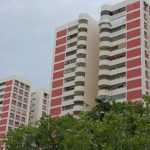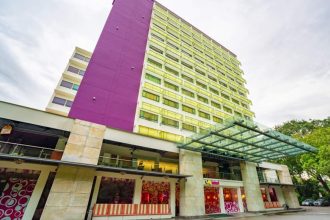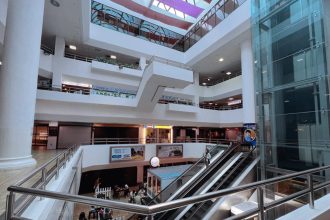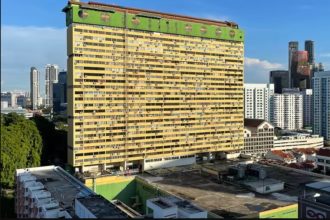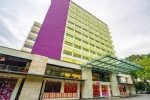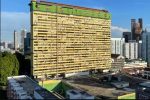Key takeaway
The Ming Court Hotel, opened in June 1970 at 1 Tanglin Road, was a pagoda‑tower hotel that brought the Ming Dynasty architectural style to Orchard Road. With 350 rooms across a high‑rise “pagoda-like” tower, it was richly themed inside and out: the roof structure, interior décor, and logo reflected Ming Dynasty motifs. Far East Organization later acquired it, renaming it Orchard Parade Hotel in 1991. Its design influenced subsequent hotel and retail developments along Orchard Road.
The Ming Court Hotel once stood as a striking symbol along Orchard Road. Built at the junction of Tanglin Road and Orchard Road, its pagoda-style tower resembled a piece of ancient China rising in the heart of Singapore’s modern shopping belt. The hotel combined traditional design elements with modern construction, offering a unique stay that contrasted sharply with contemporary hotels nearby. How did a Ming Dynasty–inspired hotel emerge here in 1970? Let us walk through its story.
The Pagoda Tower That Captured the Ming Dynasty Spirit
The Ming Court Hotel opened in June 1970 with around 350 rooms. Kumpulan Akitek designed the reinforced concrete structure, topped with a metal-clad roof supported by steel trusses. The tower evoked Ming Dynasty architecture with upward-curving eaves and ornamental motifs, making it one of Singapore’s first high-rise structures inspired by classical Chinese architecture.
Inside, the hotel extended the theme. Decorative elements, colour palettes, and furnishings drew from Ming-era aesthetics, red, gold, and white tones, stylised furniture reproducing Ming designs, and hand-painted screens. Even the hotel’s logo reflected an oriental symbol in a modern sensibility. Visitors often remarked on the immersive feeling, where every corridor and room reflected the same aesthetic logic.
Why a Ming Theme in Orchard?
Singapore actively promoted tourism development in the 1960s. The government partnered with Town and City Properties Ltd to develop the hotel, projecting luxury and prestige. Its oriental style reinforced a sense of elegance and conveyed cultural sophistication to international visitors. The hotel quickly became a reference point for travelers seeking a distinctive Singapore experience, bridging traditional Chinese culture and modern hospitality.
More Than Just a Tower: Amenities & Unique Design
The building housed a four‑storey podium deck beneath the 18-storey tower. A rooftop terrace offered a swimming pool, sauna, and health club facilities. Glass-domed courtyard spaces brought daylight into function rooms and restaurants surrounding the court. This mix of recreational and social spaces created a microcosm where guests could experience comfort, entertainment, and scenic views in one location.
Dining and social life thrived with a Chinese-style restaurant, Genghis Grill, a sidewalk café, and Barbarella, a discotheque of its era. The design encouraged guests to linger and enjoy both public and private spaces, a model that influenced later Orchard Road hotels. The podium and open courtyards added a human scale to the grand tower, helping it feel welcoming despite its height.
Construction Innovations
Pre-cast concrete floor planks marked one of Singapore’s first uses of this method in a hotel. Designers also built a full deck atop a 40-foot monsoon drain to support the structure and provide usable outdoor space. The project demonstrated a creative balance between architectural ambition and engineering practicality, helping to set new construction standards in Singapore.
The Hotel’s Journey: From Ming Court to Orchard Parade
Initially developed by Town and City Properties Ltd, the hotel opened as a first-class destination. Far East Organization acquired it in 1987, renaming it Orchard Parade Hotel in 1991. A 2018 renovation rebranded it as Orchard Rendezvous Hotel, introducing a modern botanical concept. Each transformation retained the core pagoda tower, maintaining its historical and architectural identity.
The Ming Court Hotel played an early role in shaping Orchard Road developments. Its themed tower added architectural variety and encouraged further hospitality investments along the street. The hotel’s presence coincided with the rise of high-rise retail and entertainment complexes, contributing to Orchard Road’s evolution into Singapore’s premier shopping and tourism destination.
Where It Stands in Orchard Road’s History
The pagoda-inspired tower set it apart from nearby hotels. The hotel’s construction and design complemented high-rise projects like Singapore’s high-rise architecture that shaped Orchard and Tanglin’s skyline. Its unique silhouette became a visual anchor for the area, allowing it to stand out among modernist and glass-clad buildings.
Quick Comparison With Nearby Hotels
| Building | Key facts | Nearest MRT |
|---|---|---|
| Ming Court Hotel / Orchard Parade Hotel | 18 storeys, ~350 rooms, opened 1970, themed after the Ming Dynasty | Orchard MRT, Somerset MRT |
| Mandarin / Hilton / Voco Orchard (formerly Mandarin Orchard) | 36‑storey + 40‑storey towers, opened 1971 & 1973 | Orchard MRT |
Human Stories Behind the Tower
Staff from other local hotels helped manage operations in the early years. Visitors came from near and far, enjoying the distinct oriental design and social spaces. Celebrities even stayed during tours in Singapore. Guests often recalled the feeling of staying in a hotel that celebrated art and culture, rather than focusing purely on luxury.
Transitions Through Time
Far East Organization’s acquisition in 1987 led to the 1991 rebranding as Orchard Parade Hotel. Renovations in 2018 introduced a botanical concept at Orchard Rendezvous Hotel. Despite updates, the pagoda tower remains, preserving a link between modern Orchard Road and Singapore’s architectural past.
Local Community Engagement
The hotel hosted cultural events, business meetings, and social gatherings that connected both residents and visitors. Tea ceremonies, traditional Chinese performances, and art displays allowed locals to interact with the hotel’s theme beyond accommodation. This strengthened Orchard Road’s identity as a place where commerce and culture intersected. Many community members fondly remembered attending these events, which made the hotel feel like a shared cultural space rather than just a lodging facility.
Architectural Influence on Singapore Hotels
The Ming Court Hotel inspired subsequent themed hotels and restaurants across Singapore, showing that a strong cultural identity could be a major draw for guests. Its success demonstrated that visitors appreciated spaces that went beyond standard luxury, where design reflected history, artistry, and local heritage. Developers increasingly considered both aesthetics and functionality, exploring how architecture could tell a story while providing modern comforts. This influence extended beyond Orchard Road, encouraging creative approaches in Tanglin neighborhoods and other high-profile hotel projects. Over time, architects referenced the Ming Court Hotel as a benchmark for combining cultural motifs, guest experience, and urban presence, shaping a generation of hospitality design in Singapore. It proved that thematic design could elevate a building’s status, making it memorable and culturally significant.
Integration With Orchard Road Urban Fabric
Its tower complemented nearby shopping malls, office blocks, and residential developments, creating a visual landmark that helped define the streetscape of Orchard Road. By introducing a distinctive silhouette and podium layout, the Ming Court Hotel influenced urban planning decisions, encouraging developers to consider both height and design aesthetics in new projects. The hotel demonstrated how thematic architecture could coexist with commercial and residential buildings without overwhelming them, creating a balanced streetscape that welcomed both pedestrians and drivers. Planners saw the benefit of blending cultural motifs with modern infrastructure, paving the way for more creative high-rise developments in the area. Over time, the hotel’s presence contributed to Orchard Road becoming a corridor where heritage, culture, and modern urban life intersect seamlessly.
Legacy of the Ming Dynasty Inspiration
The Ming Dynasty inspired refinement, cultural sophistication, and imperial symbolism. The hotel projected prestige to visitors and dignitaries, offering more than accommodation; it created an experience that celebrated artistry and cultural heritage. Ming Dynasty architectural style guided the overall form and interior motifs, blending traditional elements with modern construction techniques to produce a visually striking and functional hotel. Its use of colors, rooflines, and decorative patterns set a benchmark for integrating historical themes into contemporary buildings. Even today, architects studying themed hotels in Singapore reference the Ming Court Hotel for its successful fusion of history and modernity, recognizing how it influenced the design of subsequent hospitality projects that balance cultural storytelling with modern guest expectations.
The Lasting Charm of That Pagoda in Orchard
The Ming Court Hotel introduced a piece of Ming Dynasty architecture into Singapore’s bustling Orchard Road. Its pagoda-style tower and themed interiors captured attention for decades. Even with rebranding and renovations, the building’s structure and podium still carry the essence of the original design, connecting Singapore’s history with modern hospitality. Visitors and architects alike recognize its contribution to Orchard Road’s unique streetscape. Its design continues to inspire conversations about heritage-themed architecture in Singapore. The hotel stands as a reminder that thoughtful design can blend culture, history, and modern urban life seamlessly.

